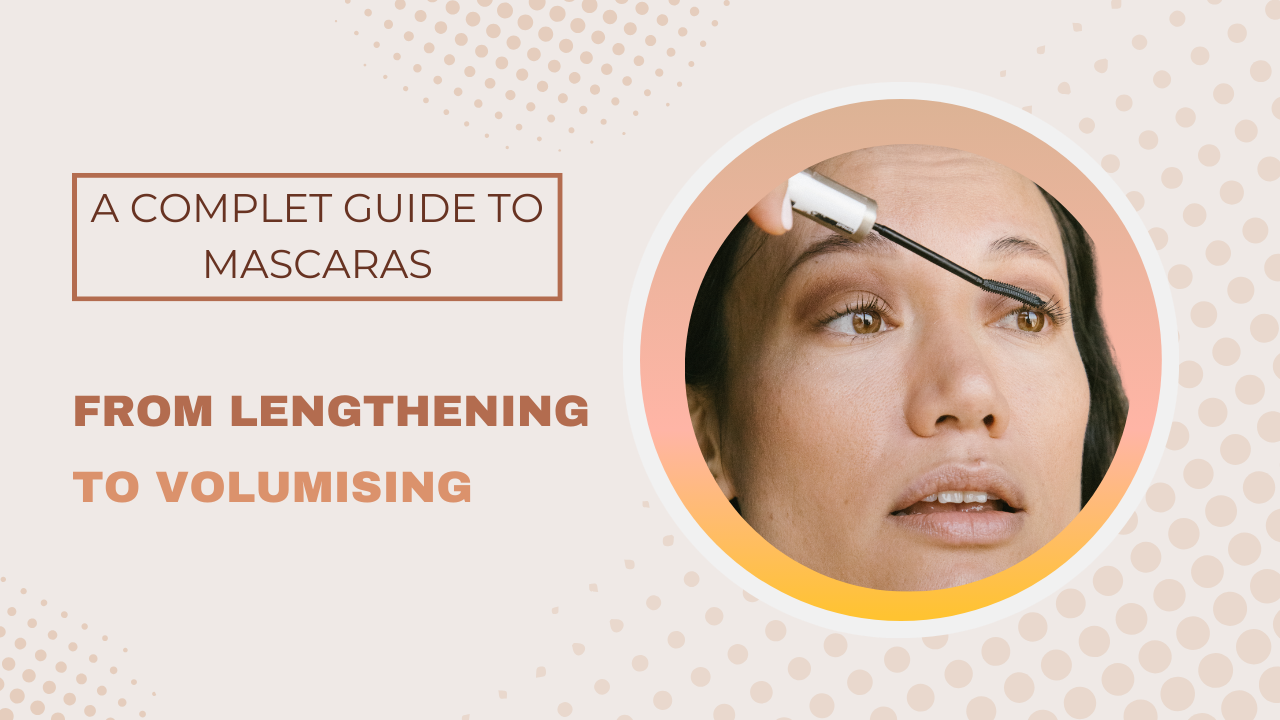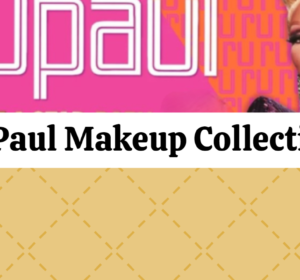Mascara is a timeless beauty essential, instantly transforming the eyes with added length, volume, and definition. From ancient Egyptians using kohl to the modern-day mascaras packed with advanced formulas and innovative wands, mascara has come a long way. But with so many types and formulas on the market, it can be challenging to find the right mascara that meets your needs, whether you’re aiming for dramatic volume, extra length, or natural-looking definition. In this post, we’ll break down everything you need to know about mascara—from different types and formulas to application tips and how to make your mascara last all day. Get ready to find the perfect mascara to enhance your lashes and elevate your makeup routine!
A bit of history
Mascara is a cosmetic specially designed for the eyelashes. It is a thick and normally dark liquid used for thickening and darkening the eyelashes.
Nowadays it is one of the most used makeup products. There are mascaras available in different colours and providing different effects.
The first product designed for eyelashes was created at the end of the XIX century by Eugene Rimmel. He made a mixture of black soap. Wax and carbon oxide. It was a very successful product but it wasn’t easy to apply. Until 1937, mascara was a compact paste that people applied with a wet brush (mostly wetted with saliva).
In 1937, Helena Rubinstein produced the first mascara with a spoolie, similar to the wand used nowadays.

Functions and requirements of mascara
Mascaras can have two different functions, cosmetic or lash treatment. Most of the mascaras have a cosmetic function, allowing longer, dense and coloured lashes.
Other mascaras can be used to treat different lash concerns, for example helping lashes to grow stronger, faster and healthier.
Some mascaras are a combination of cosmetic and treatment mascaras. They allow you to show enhanced lashes treating them at the same time.
Any mascara must meet a minimum requirement.
- As with any product designed for the eyes, it may be harmless
- It should produce an effect on the lashes
- It shouldn’t dry too fast or too slow
- Application should be easy and mascara shouldn’t produce lumps
- It should stay all day on the lashes without fading or smudging

Type of mascara
There are different ways to classify the mascaras, depending on the characteristics chosen for classification. One of them is the type of wand (also called spoolie or applicator), but that deserves a paragraph and we will consider it later. Now, we are going to see the different types of mascaras depending on the texture and the effect they produce on the lashes. Keep in mind that any mascara is a combination of effect, texture and spoolie.
Depending on the texture
We can mention three main types of mascara depending on the texture.
Powder Mascara
Powder mascara is coloured powder where you add a few drops of water to make a paste which you apply to the lashes with a wand. They are hard to apply and produce a falsies finish.
Cream Mascara
It is a coloured cream which provides volume and adds depth to the lashes. It is easier to apply than powder mascara but can smudge easily.
Liquid Mascara
Liquid mascaras are the most popular ones. They are the typical mascara coming in a tube with a wand attached to the lid. They can provide a variety of effects and they are fairly easy to apply. Liquid mascaras can exist in water-soluble and waterproof versions.
Mascara depending on the effect
Nowadays each brand has different effects mascaras available and the number of options is huge. The main effects mascara can provide are:
Lengthening
This type of mascara extends the natural lashes or makes lashes look longer. It is ideal for people with short lashes.
Normally, it contains polymers in the formula, like nylon or rayon. It normally comes with a wand with dense bristles which can coat the lashes thickly.
Thickening/Volumizing
This mascara provides volume and thickness to the lashes. Depending on the number of coats applied this mascara will look different. With one coat the effect will be natural while with a second coat, it produces a darker and more glamorous effect.
This type of mascara normally contains waxes and silicon in the formula.
Curling
Curling mascaras enhance the natural curl of the lashes. Consequently, the eyes look bigger. The application on the centre of the eye makes it look round.
Curling mascaras normally contain some polymers which contract when the product dries. This contraction produces a curl on the lashes.
They normally come with a curled wand to help with the application.
Waterproof and Smudge-proof
They are resistant to rubbing, smudging, rainwater, and sometimes even to swimming pool baths.
The formula contains wax oil, mineral oil and wax and doesn’t contain water. Because of this formula, this type of mascara tends to dry the lashes. They are not recommended for daily use.
It is advisable to remove the mascara at the end of the day with an oil-based cleanser. Also, I would recommend using lash moisturiser or Vaseline on the lashes before sleeping.
Non-clumping
Non-clumping mascaras produce a very natural look. They are the best for a no-makeup makeup look. They normally contain glycerine or silk extract in the formula. The wand is normally a long-bristle wand
Lash-defining
These mascaras provide volume and thickness at the same time. They could do that thanks to an even application over the lashes. They contain strong pigments, filming polymers and nylon or rayon fibres in the formula. The waterproof version may also contain waxes and oils.
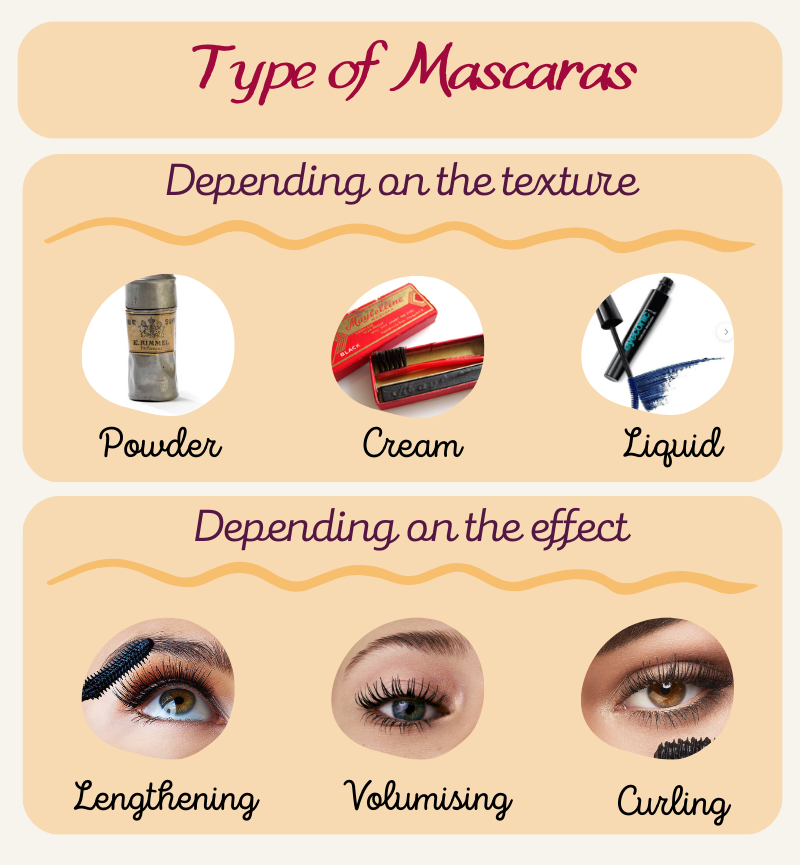
Type of mascara wands
There are two ways to classify the wand, depending on the material and depending on the shape.
There are two types of mascara depending on the material
Synthetic fibres
This is the typical and traditional wand material. The bristles are evenly distributed along a straight brush. This type of material provides a natural effect, separating and lengthening the lashes. However, it doesn’t provide so much volume. This material allows the coating of all the lashes in a second.
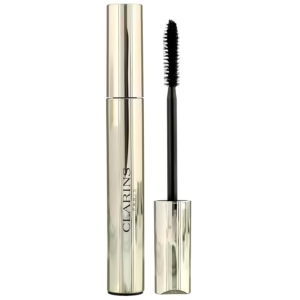
Plastic
This type of wand has spiky plastic bristles across the wand. They can come in different sizes and shapes.
This type of wand is good for separating the lashes and provides a clean, even application. Normally, plastic wands come with low-density mascaras. Therefore, you may need to allow longer time to dry between coats.
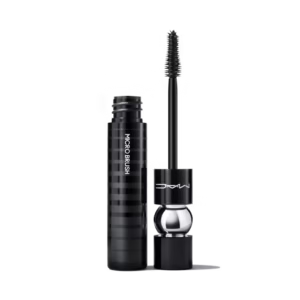
Depending on the shape and size we can identify different types of mascaras.
Round Wand Mascara
This is a classic and basic shape. They are cylinder wands with tightly packed bristles (normally fibre bristles). This type of wand is normally quite big and not easy to use, mainly over the bottom lashes.
Tapered Wand Mascara
These wands look like a cone. The bristles are longer at the base and shorter at the tip. They allow to coat the smaller lashes at the ends of the lash lines to produce a dramatic look.
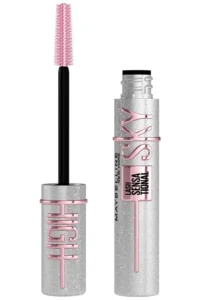
Curved Wand Mascara
This type of wand has a curved shape which helps to curl the lashes. Sometimes curved wands may produce a clumpy effect.
On these wands, the bristles are longer on the outer edge. They are ideal for people with straight lashes. These wands make the eyes look wider.
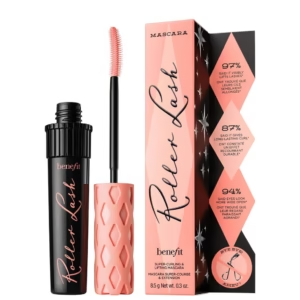
Comb
These wands have tiny bristles which resemble a comb. The shape allows separation of the lashes, providing a definition. They also help to prevent clumping. However, the effect they produce is natural.
They are ideal for mature, thin and sparse lashes.
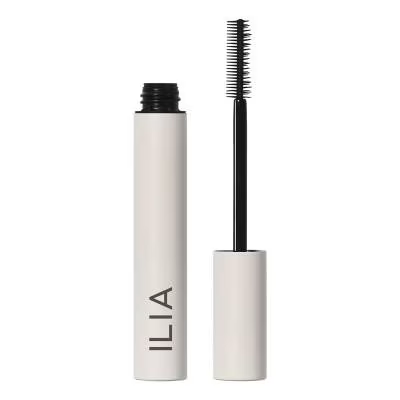
Skinny
Skinny wands are small or narrow wands. They are normally long and thin wands with tight bristles (in fibre or plastic). They mainly provide a layer of colour without providing volume or length and are ideal for a natural no-makeup makeup look. In addition, they also work well for the application over the bottom lashes.
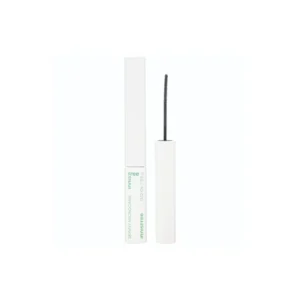
Hourglass
They have an hourglass shape, with a wide middle and thicker (tapered) ends. The wider part adds volume to the lashes while the ends help to separate them. These wands provide a dramatic look.
The shape helps to evenly distribute the mascara, coating it from root to tip.
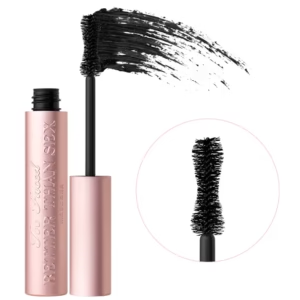
Ball Tip
These are a special type of wand consisting of a round ball at the end of the brush. They have slightly packed bristles and they are ideal to reach every corner.
These wands add volume to the lower lashes as well as the internal and external corner lashes.
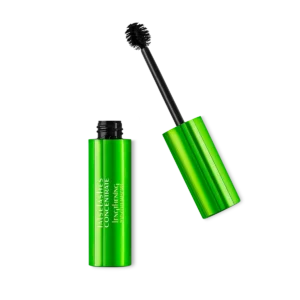
Oversized
They are a jumbo-sized brush, which makes the lashes look thicker. Oversized wands provide volume and thickness at the same time. They provide a doll-like look.
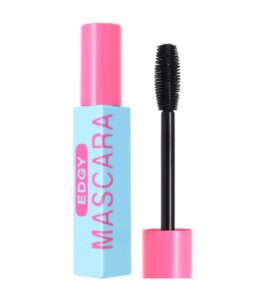
Bottom Lash
Bottom lash wands are small wands with few bristles to make the application over the bottom lashes easier. They are large enough to coat all the lash lines with a single stroke.
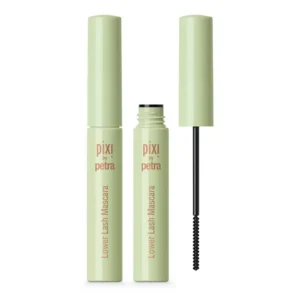
Blendable
Blendable wands are flexible brushes where you can bend the wand to reach any corner of your lashes easily.
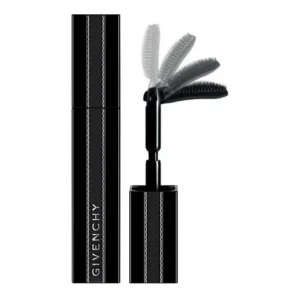
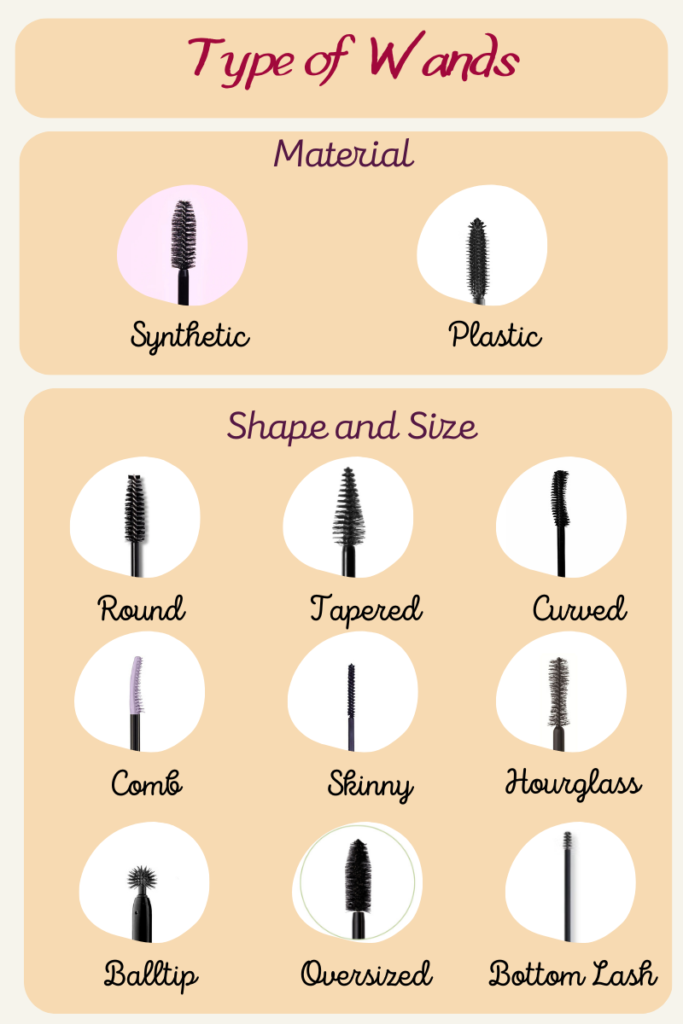
Mascara Formulation
When talking about mascaras, we can distinguish two main parts of the formulation. On one side, we have the vehicle and on the other side, we have the additional ingredients.
The vehicle normally includes water, waxes, oils, silicones, polymers and resins. Among additional ingredients, we can find ingredients for colour, texture, curling, and lengthening, as well as ingredients to allow an easy application (to control viscosity, density, drying,…), preservatives, and more.
The basic formula of a mascara is:
| Compound | Concentration (%wt) |
|---|---|
| Colour | 1-12 |
| Emulsifier | 3-10 |
| Emollient | 25-50 |
| Texture Modifiers | 5-20 |
| Preservatives | 0-15 |
| Film Former | 1-8 |
| Solvent | 0.5 |
Vehicle ingredients
Water
Water is the main ingredient in non-waterproof mascaras. Normal mascaras are water-based emulsions. However, water may not be present in waterproof mascaras.
Waxes
Waxes may have different functions on the formula. Waxes make mascaras waterproof, but also protect and provide density to the lashes.
Mascaras normally contain a combination of hard and soft waxes. Adherence and flexibility of the formula depend on this combination. Hard waxes help the soft wax to adhere to the lashes.
The most important hard waxes are carnauba wax, candelilla wax and rice wax. Among the soft waxes, we can mention jojoba wax, beeswax and ozokerite.
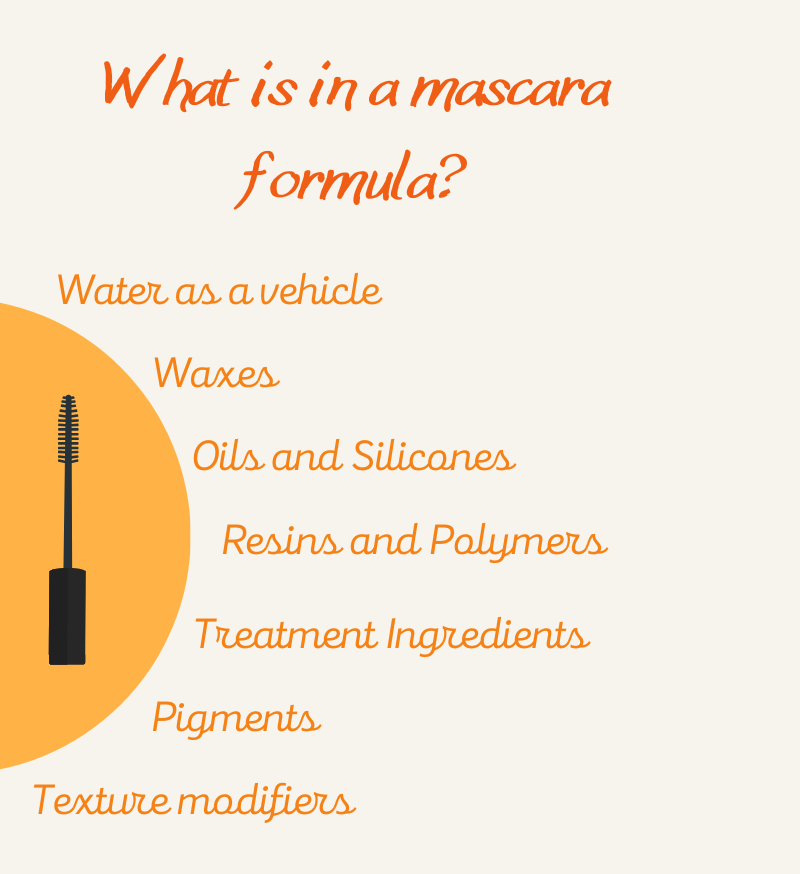
Oils and silicones
The most used oil in mascaras is paraffin, whereas in waterproof mascaras the most important is the isododecane.
Silicones protect the mascara from moisture coming e from tears, accelerate the drying process, provide a shiny finish and allow a smooth and even application.
In addition to paraffin and isododecane, there are other oils and silicones present in mascaras like dimethicone derivatives (dimethicone copolyol, PEG-9 dimethicone), volatile silicones (cyclomethiconol) and high molecular weight silicones (dimethiconol).
Resins and polymers
Resins and polymers are ingredients added to mascaras recently. They form a film around the lashes, allowing them to look curled. They can keep the lashes curled for a long time.
The ingredients used as resins and polymers are cellulose derivatives (hydroxy-ethyl-cellulose), polyvinyl alcohols derivatives, quaternary polymers (polyquaternium-10), vinyl-acrylic acid derivatives (alyl stearate/VA copolymer) or vinyl-pyrrolidone derivatives (PVC/eicosane copolymer).

Additional Ingredients
This group comprises different types of ingredients, including treating ingredients, pigments, preservatives, and more.
Treatment Ingredients
Not all mascaras contain ingredients to treat the lashes. The variety of ingredients in this group is huge. The main are:
Hydrolysed keratin. Creates a film around the lashes which protects and hydrates them.
Panthenol. Helps with the lash growing. It slowly penetrates the lashes helping to retain moisture.
Amino acids. They strengthen the lashes.
Mucopolysaccharides. Strength and hydrate the lashes.
Vegetal Sugars. Normally they have hydrating properties.
Ceramide R. Keeps the lashes’ structure.
Pigments
The most frequent pigments are based on iron oxide. Mascaras are normally black and the pigment added is black iron oxide. This colour can be modified by adding other pigments, normally mica-based.
Sometimes, we can find other ingredients which help with the dispersion of the pigments. They also help to make the formula stable. These dispersion ingredients are normally titanium dioxide (TiO2) or acrylic acid/dimethyl polysiloxane copolymer solved in volatile silicone.

Texture modifiers
Different compounds are used to modify the mascara texture. Thickeners make the formula thicker increasing the viscosity. The compound used is hydroxycellulose.
Oils are added to make the formula fluid and to allow a smooth application.
Waxes added to the formula make the product hard after drying.
Auxiliary ingredients
It is important to mention the emulsifiers, added to stabilise the dispersion, like the myristoyl hexapeptide.
The emollients hydrate the lashes. The usual emollient ingredients are jojoba oil, wheat germ oil and argan oil.
Preservatives are important to increase the shelf-life or PAO of the product. The most popular preservatives are phenoxy ethanol derivatives or parabens. Mascaras also contain antioxidants (tocopherol acetate) and compounds to keep the product pH like the skin pH value.
Finally, we can also mention the anti-flaking ingredients. They are normally polymers which form a sort of net around the lashes and prevent them from being in contact with water or tears. At the same time, anti-flaking ingredients prevent mascara breakage.
Common Ingredients
The most common ingredients found in mascaras are:
Beeswax: as a thickening agent
Lanolin: to help coat individual lashes
Mineral oil: to increase viscosity
Castor oil: thickening and nourishing ingredient
Paraffin: moisturiser
Iron Oxide: colouring agent to create black, yellow and red
Glycerine: moisturiser
Guanine: for a glossy effect
In addition, if the formula is waterproof, mascara may contain:
Emollients: isododecane
Silicone: dimethicone copolyol (adheres to the lashes and repels water)
Waxes: beeswax or candelilla wax
In a few words, we can summarise the ingredients in mascaras as:
- Pigments to darken
- Polymer to coat
- Preservatives to keep it fresh
- Thickeners to give texture
All of them carried by a vehicle
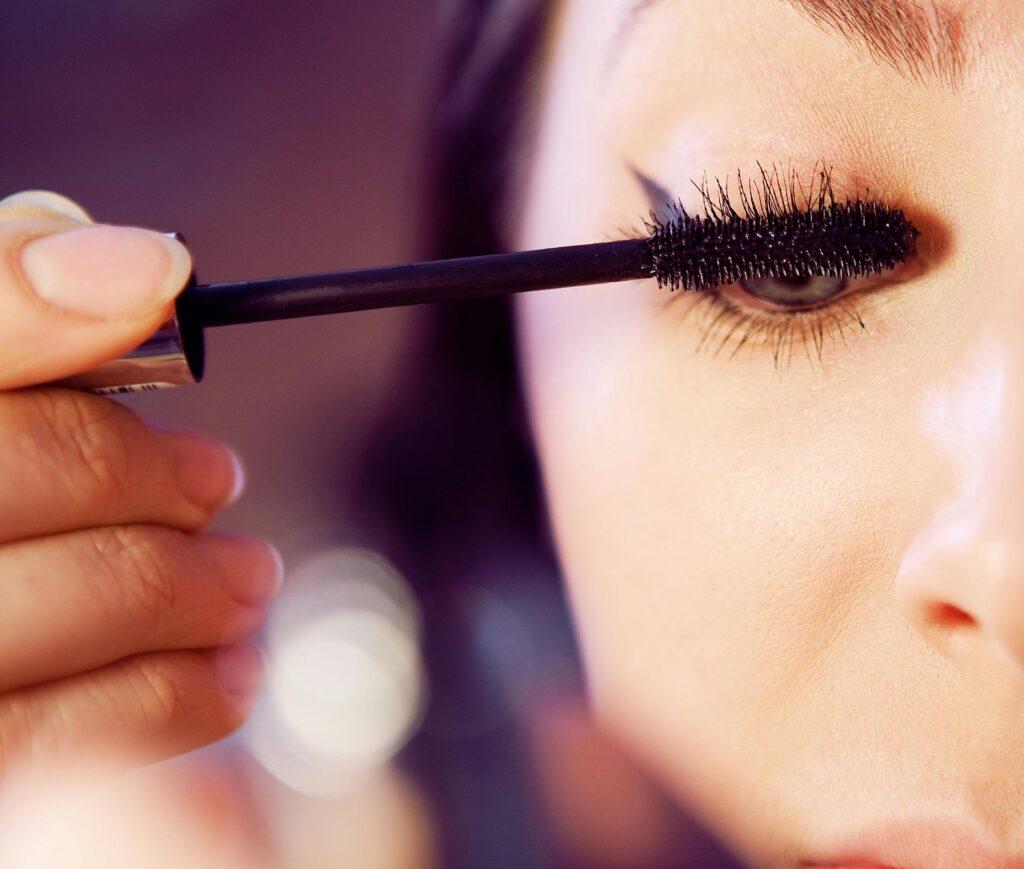
Which mascara should I use if……
I have short lashes and small eyes?
Use short wands. They can go closer to the root and increase the lash length
I have lots of lashes without length and definition?
In this case, choose a comb or skinny wand. They have evenly spaced bristles which helps to length lashes
I have long lashes without volume?
Use a round wand with dense bristles. Dense bristles help to coat the lashes creating a thicker-looking lash
My lashes are too straight?
Choose a thick and curved wand. Normally, as thicker the brush the bigger the curl. Sweep the wand over the lashes from root to tip
My eyes are big, and I want a natural look?
In this case, I recommend you a straight wand. They provide natural volume and curl
I want precision when applying the mascara?
Choose a precision wand like the round, tapered or spiral one.
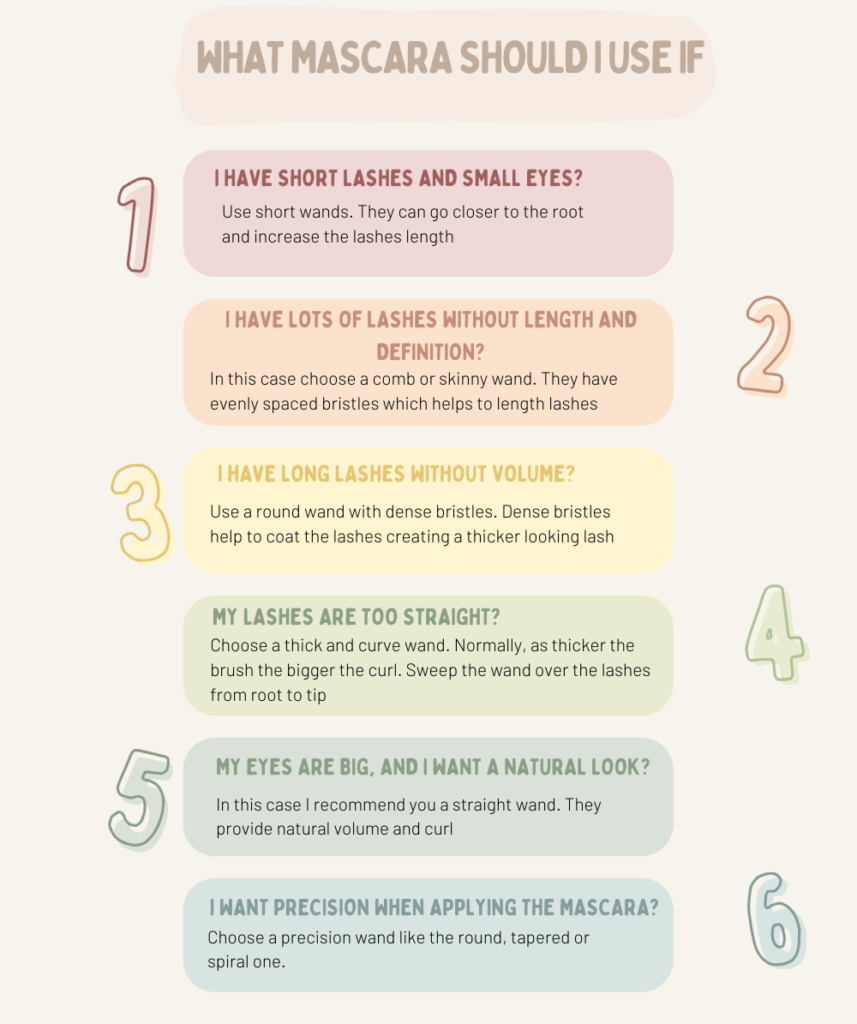
How to clean your wand
Very few people keep the mascara wand clean. However, it is very important to keep it clean as a dirty wand can produce eye irritation or infections.
When applying the mascara, always wipe the excess product with a tissue before going to the lashes. That will help to achieve a clump-free application.
Limiting the number of times, you dip the wand into the tube will elongate the mascara shelf-life, as dipping it too much introduces air, which can oxidise the product.
If after applying the mascara your lashes are clumpy, you can remove the clumps with a disposable spoolie if the mascara is still fresh or with a lash comb if the mascara is dried.
For a neat application apply the mascara in zigzag movements from root to tip, coating evenly all the lashes. If you are going to apply a second coat, make sure the first coat is fully dry before applying the second.
Don’t forget to remove the mascara before going to bed and to nourish your lashes. Apply a nourishing ingredient, like castor oil, a couple of times a week if you use water-soluble mascara and every time after using a waterproof mascara.
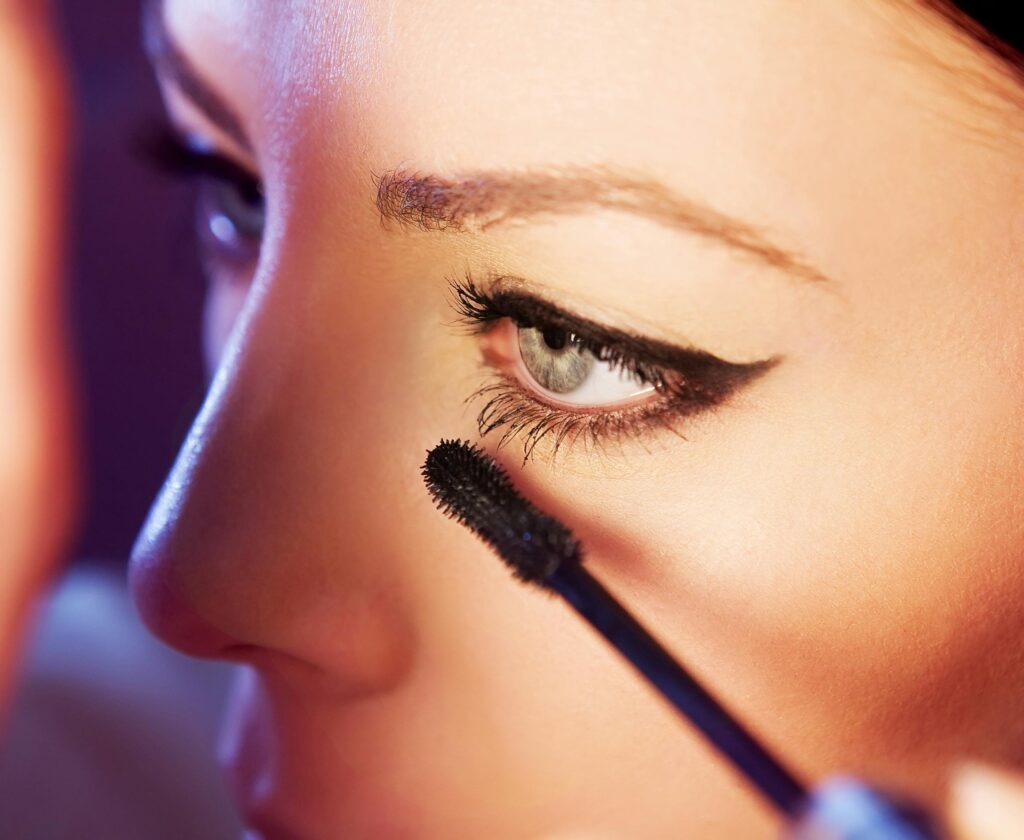
Whether you’re a fan of subtle enhancement or love making a bold statement, the right mascara can be transformative. With options that cater to length, volume, curl, and even conditioning benefits, there’s a mascara for every preference and lash type. Understanding the different formulas, applicators, and ingredients will help you make an informed choice that brings out the best in your lashes. So go ahead, and experiment with various mascaras until you find the one that makes your eyes pop! And remember, the journey to perfect lashes starts with knowing what works best for you.
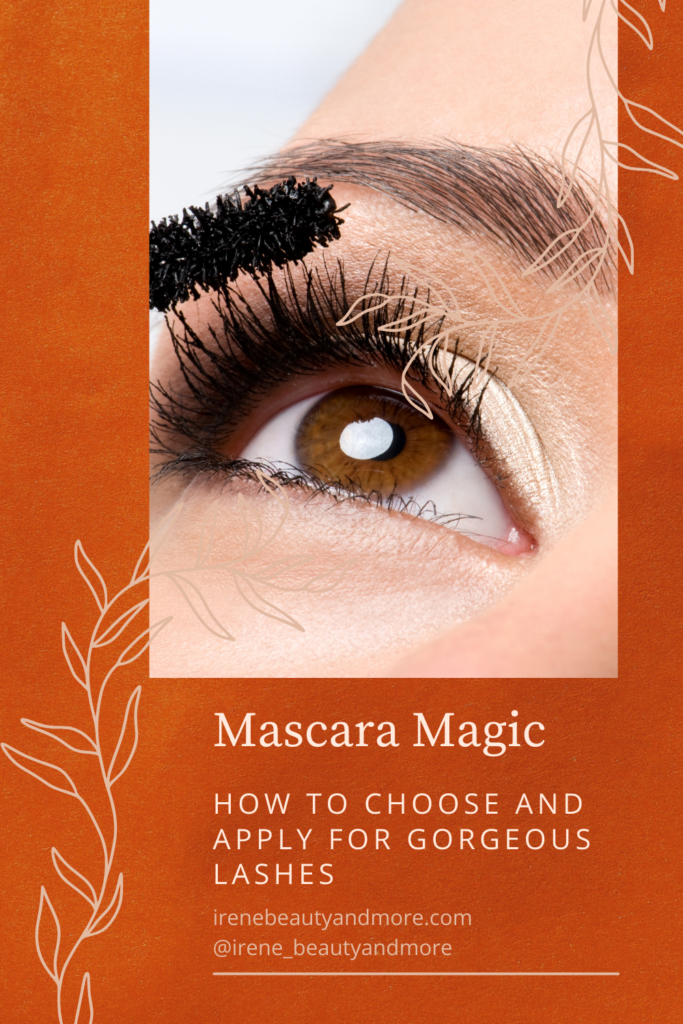
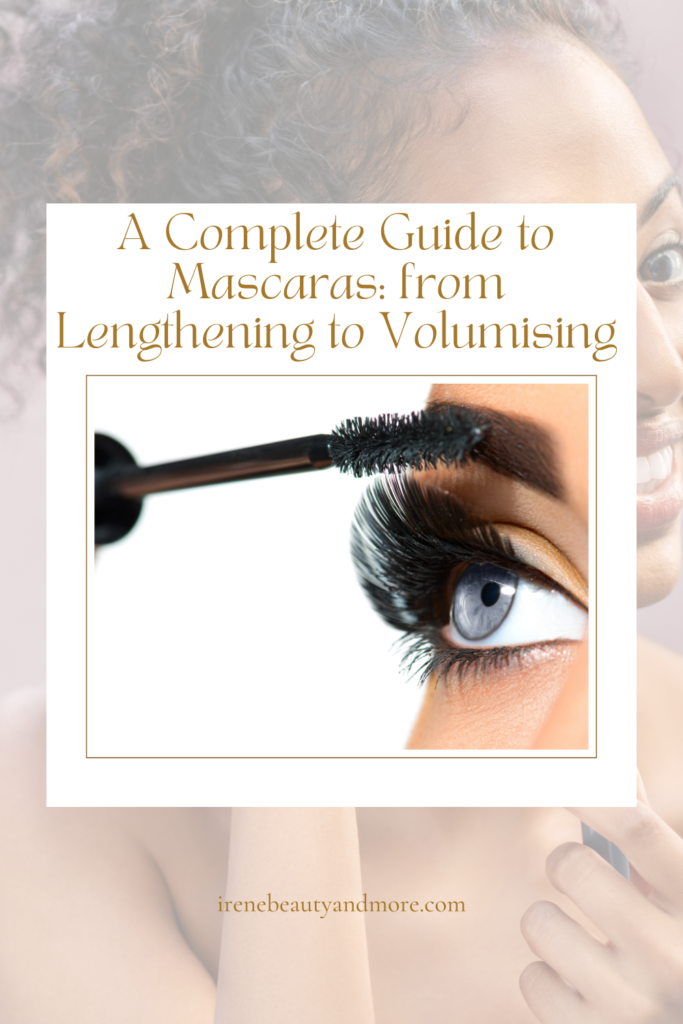
Bear in mind that some of the links in this post are affiliate links and if you go through them to make a purchase I will earn a commission. Keep in mind that I link these companies and their products because of their quality and not because of the commission I receive from your purchases. The decision is yours, and whether or not you decide to buy something is completely up to you.
